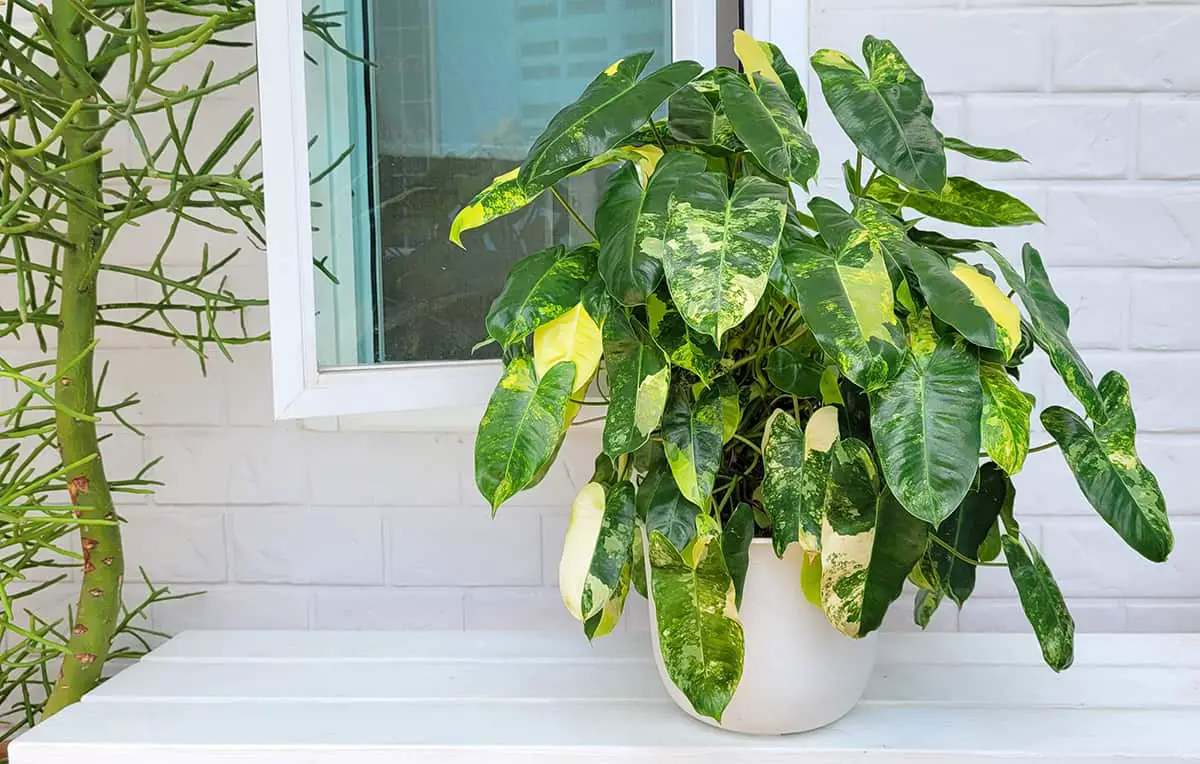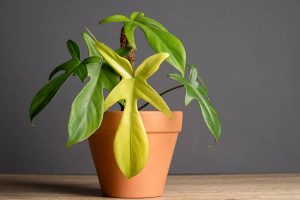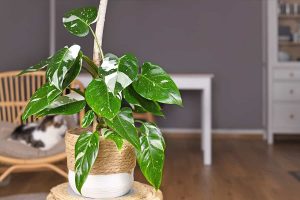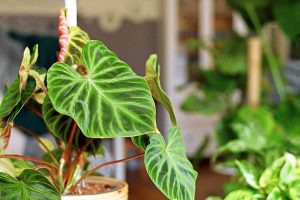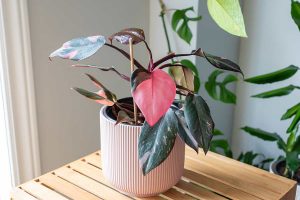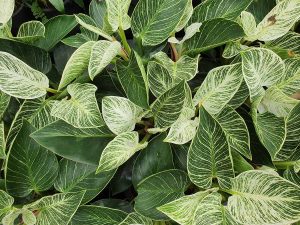This is one of the less common types of Philodendrons grown as houseplants. It is native to the tropical rainforests of Brazil and is named after Roberto Burle Marx, who was a world-famous Brazilian landscape architect with a particular interest in using tropical plants in modern garden design.
The Philodendron Burle Marx has foliage shaped like elongated hearts or arrows in a bright green color. The leaves have a subtle pleated effect which gives them the look of gentle ripples. The stems of the plant are usually red, and they grow in low clumps or can climb structures.
| Botanical name | Philodendron burle-marxii |
| Common names | Burle Marx Philodendron |
| Plant family | Araceae |
| USDA hardiness zone | 10 – 11 |
| Mature height | 2 feet |
| Mature spread | 3 feet |
How to Care for Your Philodendron Burle Marx
If you want an easy-to-care houseplant that stands out from the crowd, then the Philodendron Burle Marx will fit your criteria. This tropical plant is not demanding in terms of its care requirements and can adapt to a range of environments.
To get the most out of your Philodendron Burle Marx, follow these care guidelines.
Light
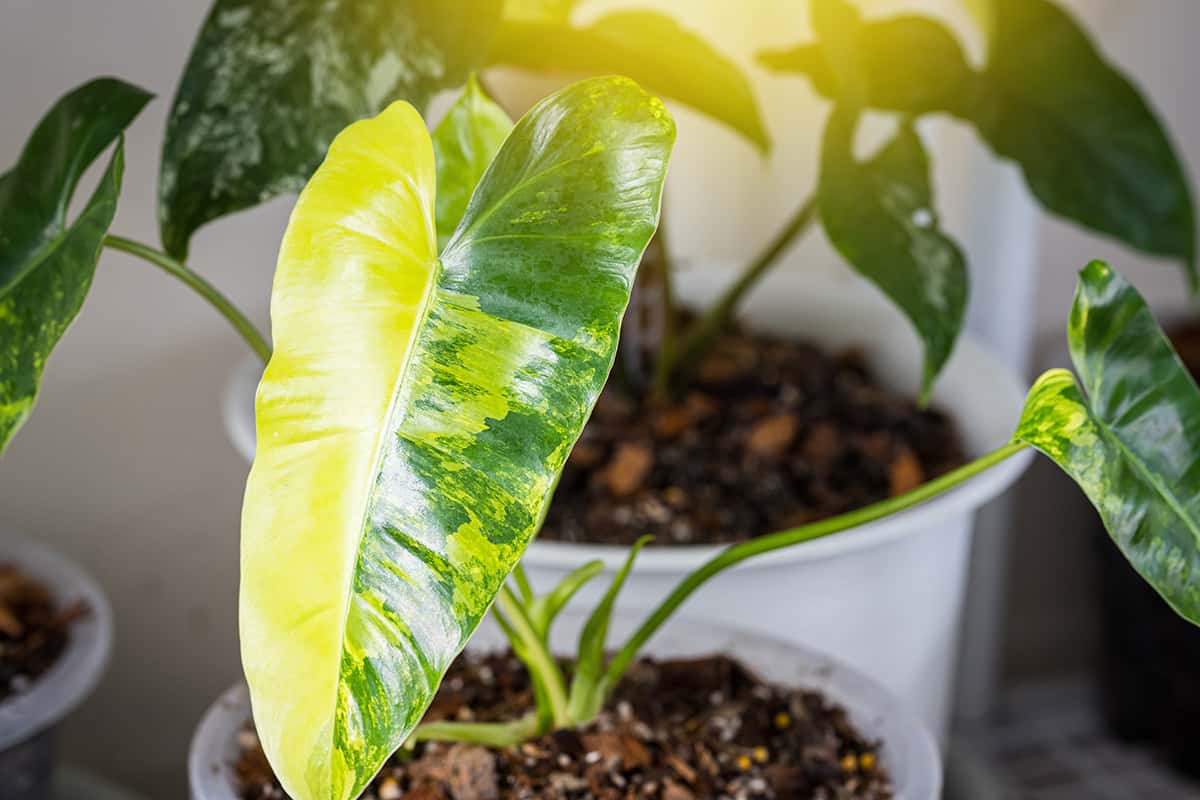
The Philodendron Burle Marx is a low-growing climber in its natural habitat. This means you will find it creeping across rainforest floors as ground cover or climbing up the side of trees and shrubs.
As a low-growing plant, the Philodendron Burle Marx is not accustomed to receiving a lot of direct sunlight since it will spend much of its time under the dappled shade of taller plants. As a result, this plant can survive in low light settings, for example, in an office that lacks windows or in the back corner of a northern aspect room.
If you’re looking for a plant that will tolerate high levels of shade, then the Philodendron Burle Marx is an option, however, if you really want it to thrive, then you should provide it with the opportunity for several hours each day of indirect light.
A windowsill in a north-facing room would be ideal or set it in a bright south-facing room with sheer drapes at the window to diffuse the light. The worst position for this plant will be in direct light because this will cause the leaves to scorch, leading to discoloration and the slow demise of the plant.
Soil
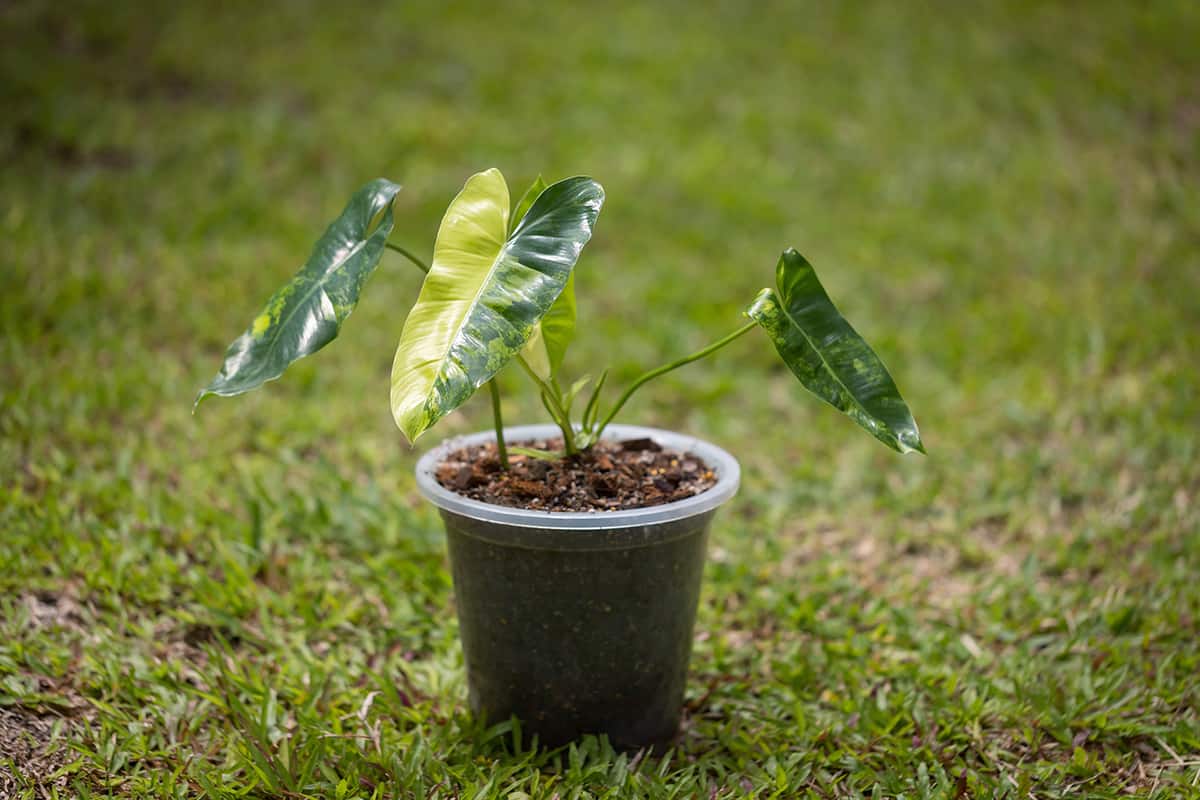
Like most houseplants, well-draining soil is essential for the Philodendron Burle Marx. A soil that drains freely will allow any excess water given to the plant to drain away through the holes on the base of the plant pot, serving to protect the roots from sitting in water which will cause them to rot.
The Philodendron Burle Marx can be grown in pre-mixed soil, or you can create your own by mixing compost, peat-free soil, and sand or perlite together.
Water
The Philodendron Burle Marx is not a thirsty plant, but it is also not tolerant of drought. Getting the watering pattern right is probably the most important way to ensure the health of this plant because getting it wrong can be fatal. If you overwater the Philodendron Burle Marx, then it will be destined to die from root rot, which is one of the leading causes of death among all houseplants.
Underwatering, on the other hand, will also cause the Philodendron Burle Marx to die if you don’t remedy it soon enough. Aim to strike a balance between underwatering and overwatering by providing the soil with just enough water to stay moist.
The best tactic is to water the plant deeply until you see water seeping out of the bottom of the pot. Wait a few minutes for any extra water to drain out, and then discard this water. Now your soil should be adequately moist but not soggy.
The next time you go to water the plant, dip your finger a few inches deep into the soil to test it for moisture. If the soil is still moist, it doesn’t need to be watered again yet. Wait another few days before testing again with your finger.
Once the top few inches of the soil are dry, then you can water the plant again, repeating the method of waiting for the water to seep out of the base of the pot. This method will ensure you don’t overwater the plant, but you’ll also need to remember to not leave too much time between each watering, otherwise, the soil will completely dry out and deprive the roots of any moisture.
During spring and summer, you can expect the Philodendron Burle Marx to need watering roughly once a week, and this will dramatically reduce during fall and winter to around once every 3 to 4 weeks.
Temperature
This plant performs best when grown in temperatures between 64-80°F. This level of heat is what the Philodendron Burle Marx would be used to in its natural habitat, and it works well as a houseplant because the average room temperature in homes also falls into this range.
The Philodendron Burle Marx can be grown outdoors in hardiness zones 10 to 11. It is a tender plant which will not survive frost or temperatures lower than 50°F, so avoid planting it outside in cool climates, or remember to overwinter it inside your home.
Humidity
Philodendron Burle Marx plants are native to tropical rainforests, which means they are accustomed to growing in high humidity. If you want to keep your plant ultra happy, then maintain high levels of humidity in your home by spritzing the leaves of the plant with a water mister spray every day or two.
As a fairly low-maintenance plant, the Philodendron Burle Marx does not require humidity as an absolute essential, so don’t worry if your home is not a humid environment.
Fertilizer
Some plants require additional nutrients from fertilizer to grow, but the Philodendron Burle Marx is not one of these plants. During the growing season you can help to keep your plant healthy with low doses of monthly liquid fertilizer, but this is not essential.
Propagation
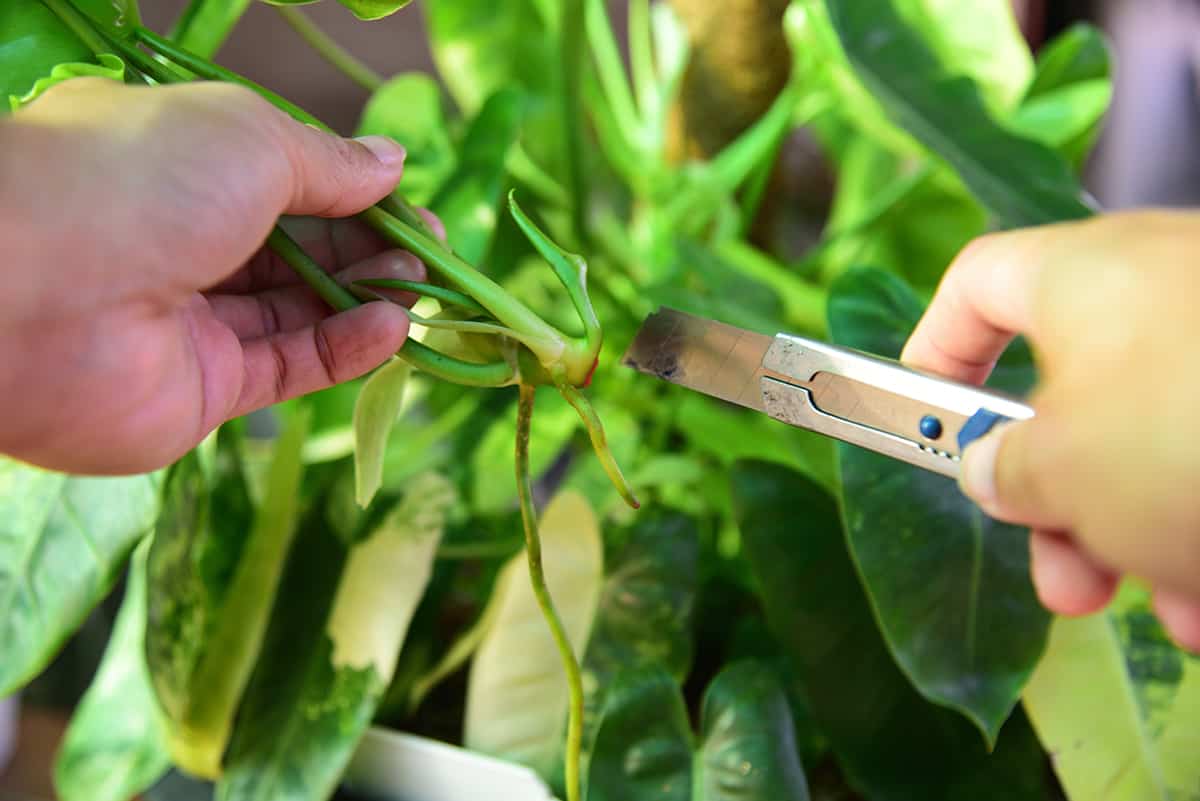
Creating new Philodendron Burle Marx plants is easy, using stem cuttings for propagation. To do this, you will need to take a cutting from your plant that is around 4 inches long, ensuring there is at least one leaf node on the stem.
Remove the leaves from the upper portion of the stem, then bury the lower, leaf-free part of the stem in moist soil. The stem cutting will need to be situated on a warm, bright windowsill, and the soil will need to be kept moist but not wet for several weeks.
After around two weeks, gently tug on the stem, and if it offers resistance, then this means roots have formed and are anchoring it into the soil. Leave the cutting in its original pot for a few more weeks so that roots can develop and strengthen, and then transplant it to a bigger pot or directly into the soil in your garden.
Philodendron Burle Marx FAQs
How long does a Philodendron Burle Marx live for?
These plants have a relatively short life expectancy of around four years, which is low compared with the average Philodendron lifespan of up to 20 years. If your Philodendron Burle Marx has matured to an old age, you can propagate some of the stems to create a new, younger generation of plants.
The life span of this plant will be very much dependent on the level of care you give it, so pay attention to its needs if you want to extend its life.
Can Philodendron Burle Marx live outside?
Yes, the Philodendron Burle Marx can live outside, but only in hot climates which imitate the temperature of its native homeland of Brazil. USDA hardiness zones 10 and 11 are the only appropriate climates to grow this plant outside unless you keep it outside in the summer and move it indoors in the winter.
Is Philodendron Burle Marx easy to grow?
Yes, this is an easy plant to grow, which produces new leaves at quite a rapid rate when it is being well cared for.
As the Philodendron Burle Marx grows quickly, you may soon find that the stems are hanging down outside of the pot and looking a little messy. You can trim these back and use them to propagate the plant, or you can transfer the plant to a hanging planter, where the stems can trail downwards.
Is Philodendron Burle Marx resistant to pests?
This plant is not typically associated with having pest issues, but it isn’t entirely resistant. Pests that you might find making a home on your Philodendron Burle Marx include aphids, mealybugs, and scale insects. If you spot an infestation, don’t panic and dispose of your plant.
Instead, isolate it from your other plants to avoid allowing the infestation to spread. Take the plant outside to wash it with insecticidal soap, and hose it down to remove as many of the pests as possible. Repeat this method daily until all signs of the pests have disappeared.
